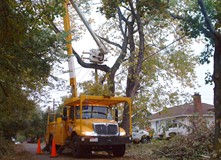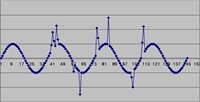
| Energy in Nature | Inventors & Inventions | Workbench Fun | Physics Lab |
|
Consumer Products | Computers | Automation & Robotics | What's in the Future |

Types of electrical power disturbances
● Lightning
Arresters & Surge Suppressors Surge Suppressors are much more common to the consumer, but serve an almost identical purpose. They can either divert voltage surges and spikes to a grounding conductor, or simply short-circuit these disturbances between the pair of circuit conductors. Rather than a simple spark gap, these devices use more sophisticated components - most commonly MOV's (metal oxide varistors). They are usually rated in two ways: Response sensitivity - referred to as clamping voltage - is the voltage at which point the device activates to divert or short-circuit the voltage surge or spike. An average value for a consumer market unit is about 400 volts. Although this is several times the normal operating voltage of a computer or other electronic appliance, it is usually low enough to prevent damage since the "clipped" surge or spike normally has a very short duration. The other rating is the amount of electrical energy that the device can absorb without being destroyed, and is usually expressed in joules. Since lightning strikes are immensely powerful a higher "joule" rating is always better. It would be impossible to find a device that could handle a direct lightning strike, but because they statistically strike some distance from the home or business their energy is able to dissipate before reaching the surge suppressor. Finally, these devices come in many different forms. "Hard-wired" units connect directly to the main circuit panel and can protect all circuits within a building. These are also usually more robust and can absorb more energy with a typically higher joule rating. At the "low end" is the ubiquitous plug-strip. These usually have a low joule rating but are inexpensive and much better than nothing at all. My advice is to use both forms if possible since multiple units have a better chance of trapping and absorbing damaging voltages. If possible, also have a qualified electrician check the integrity of the branch circuit and electrical service grounding. Since these devices divert much of the harmful electrical energy to the ground terminal a solid grounding path is important to effective operation. EC&M: "Rise of Residential Surge Protection" ● Voltage Regulators &
Line Conditioners Line conditioners take the voltage regulator a step further, but are also more expensive. They protect against, voltage sags, surges, spikes & transients, line noise, and can even "ride through" partial sine wave cycle outages and smooth small variations in sine wave frequency. Variations in frequency however, are rare with utility power, and typically are not a cause for concern. As with surge suppressors, solid circuit grounding is important for maximum benefit. ● Uninterruptible Power
Supplies (or UPS units) The "standby" UPS unit is the least expensive and typically provides surge suppression and noise filtering during normal utility power. It also contains a battery that is kept in a charged condition. During a voltage sag, surge, or blackout an AC inverter starts operation from the battery and the load is switched to the output of the AC inverter. This happens so quickly that the connected load is not affected by the instantaneous switchover. True "on-line" UPS units are typically commercial grade and used for highly critical loads such as data centers and medical and research equipment. They are also much more expensive and not normally necessary for small computers and servers. With these units the load is continuously powered by an AC inverter that is connected to a battery bank. The incoming utility power is rectified to DC voltage to maintain full charge on the battery bank. When a blackout occurs the AC inverter continues to supply power to the load using DC power from the battery bank. When normal utility power is present, maintenance of this system may be performed by manually bypassing the AC inverter.
● Backup Generating Equipment Sophisticated backup generator systems are available that incorporate an automatic transfer switch. This piece of equipment will sense the loss of utility power, automatically start the generator, and then transfer the load to the generator after it has had time to warm up and circulate its engine oil to minimize wear. When utility power is restored it will sense this as well, transfer the load back to the utility power, and then shut down the generator after a programmed cool-down period.
NECdigest:
"Residential Standby Power Systems" Also, we will discuss computer and data backup methods and ways to recover systems after a disaster. COMPUTERWORLD: "The Ultimate Backup Guide" InformationWeek: "Recovery Apps Bring Your PC Back From The Dead" |
Home | About Us | Advertise | Submit an Article | Submit a Link | Contact Us
Copyright © 2006 electricalfun.com - All rights reserved
 On
October 12th a freak snowstorm began in Buffalo, New York - where
our office is located. Accompanied by lightning, a heavy blanket of
snow fell, and because the trees had not lost their leaves yet, they
collected more weight than their limbs could support. By the morning
of Friday the 13th nearly half a million homes and businesses had
lost electrical power. Due to some earlier prudent tree trimming by
our utility company, multiple surge suppressors, and uninterruptible
battery backup equipment we were able to stay in operation with only
a few small glitches. The experience, however, gave us the idea that
it would be helpful to our visitors to provide a comprehensive look
at how to prepare for such problems in the future.
On
October 12th a freak snowstorm began in Buffalo, New York - where
our office is located. Accompanied by lightning, a heavy blanket of
snow fell, and because the trees had not lost their leaves yet, they
collected more weight than their limbs could support. By the morning
of Friday the 13th nearly half a million homes and businesses had
lost electrical power. Due to some earlier prudent tree trimming by
our utility company, multiple surge suppressors, and uninterruptible
battery backup equipment we were able to stay in operation with only
a few small glitches. The experience, however, gave us the idea that
it would be helpful to our visitors to provide a comprehensive look
at how to prepare for such problems in the future. A
clean, stable alternating current sine wave
A
clean, stable alternating current sine wave Voltage
Sag
Voltage
Sag Voltage
Surge
Voltage
Surge Voltage
Spikes & Transients
Voltage
Spikes & Transients